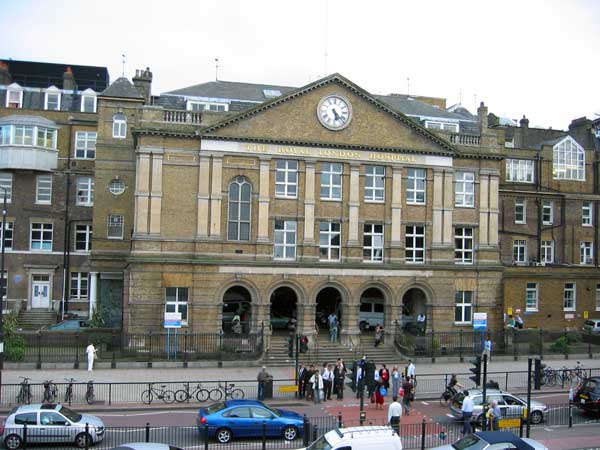Peter Hart
Chicago, Illinois, United States

The Royal London Hospital, known as The London, is one of the largest and busiest hospitals in England and has an international reputation for excellence in many fields of medicine and dentistry.
It was founded in 1740, at a time when London had become the largest city in Europe and soon was to be the largest port in the world and a major center of manufacturing. At this time, the war of Jenkins’ Ear between England and Spain was being fought. George II was king and Robert Walpole was prime minister. But for the people of the East End of London, the year was more notable for the troubles it brought—a severe winter, a bad harvest, an ever-present threat of disease. It was in this atmosphere of gloom that seven men—John Harrison (a surgeon), Josiah Cole (an apothecary), Fortherly Baker (a lawyer), and several others—founded the London Infirmary. It was to care for the sick poor of the merchant seamen and manufacturing classes and, by extension, for the many poor attracted to the East End of London by the promise of prosperity. They came from the English country side and also from other parts of Britain, Ireland, and Europe.
The London grew rapidly in size and reputation. It became famous in Britain and the world. There, many famous physicians trained or established their careers. James Parkinson, graduating in 1776, became famous for describing “paralysis agitans,” the shaking palsy now known as Parkinson’s disease. Sir Frederick Treves, another graduate of The London, cared there for Joseph Merrick, the “elephant man,” whom he had rescued from a peep show, who spent there the last days of his life and whose mounted skeleton can be seen at the London Hospital Medical School. Other famous physicians included Dr. Barnado, recognized for his work on destitute children; Dr. Morell Mackenzie, founder of British laryngology; Dr. Thomas Davies, a Welshman and pupil of Laennec; and John Yelloly, one of the founders of the Royal Medical and Chirurgical Society (later the Royal Society of Medicine) and who also prepared the hospital’s first pharmacopoeia.
Also at The London, Dr. Archibald Billing introduced bedside teaching into clinical medicine, a first of its kind in England. Thomas Blizzard Curling discovered a relationship between burns and duodenal ulceration and has his name applied to this form of stress ulcer to this day. William John Little, a surgeon who himself had a “club foot” from perhaps poliomyelitis, was a pioneer of orthopedic surgery and established the Royal National Orthopaedic Hospital. James Mackenzie founded cardiology at The London, and under his leadership Martin Flack and Arthur Keith discovered the pace maker system, later to evolve into the life-saving artificial pacemaker to which many people owe their lives. Also notable were Eva Luckes, a great leader and pioneer of nursing trained according to the Florence Nightingale principles; Edith Cavel, heroine of World War I, was matron of the first nurse training school in Belgium and shot by the German army for treason; and Sydney Holland-Viscount of Knutsford, a great leader, known as “the prince of beggars” and remembered for his fundraising, administrative, and organizational skills.
The Royal London Hospital, located at Whitechapel since 1757, has some of the best clinical services, teaching, and research in the UK. It is the base of the HEMS helicopter ambulance service and has one of the busiest emergency and trauma centers in the United Kingdom. Its medical college was founded by John Maddocks (a physician) and William Blizzard (a surgeon) in 1785—the first medical school in England, a venture of enterprise and originality with the primary purpose of improving medical education and patient care for the East Enders. The London continues to provide an intellectual and physical environment in which successful research can flourish. Its many innovations include vaccination to lower periodontal disease; research into the nature of inflammation in joint and gastrointestinal disorders; advances in cardiac, brain, and joint replacement; and ingenious applications in therapeutic endoscopy.
The London has a museum located in the crypt of a 19th century church that covers the history of the hospital and of medicine in the East End. The forensic medicine section includes original material on Jack the Ripper, Dr. Crippen, and the Christie murders. The TV series Casualty 1906, 1907, and 1909 were set at The London and followed everyday life of the hospital throughout these years. Indeed, some of the storylines are based on actual cases drawn from hospital records.
The motto of the hospital is “Humani nihil a me alienum puto” (I am human; therefore any human concern is my concern). Today the East End of London is still home for immigrants from all over the world (Asia, Eastern Europe, Africa, and the Middle East), and the London Hospital still cares for them as it did their predecessors in 1740. It has kept faith with this resolve and purpose, and it remains a beacon of extraordinary service and treatment for its community, the United Kingdom, and the world.
Reference
- Daunton, C. The London Hospital Illustrated: 250 Years. London: Batsford, 1990.
PETER D. HART, MD, FACP, FASN, is the system chairman of nephrology, Cook County Health and Hospitals System and associate professor of medicine, Rush University Medical Center, Chicago, Illinois.
Highlighted in Frontispiece Volume 5, Issue 1 – Winter 2013

Leave a Reply